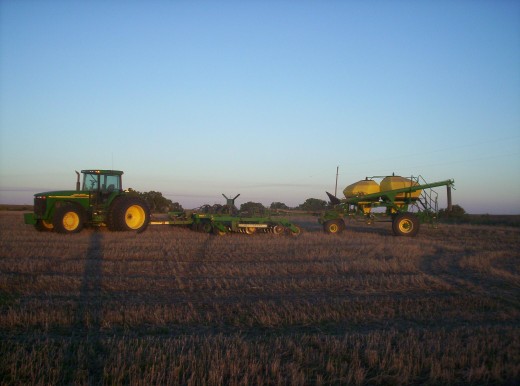Our fields have dried out enough that soybean harvest and wheat seeding could resume today. The rain and cool weather last week stopped harvest and seeding until the fields were dry enough that our equipment would not leave ruts, and that the moisture of the soybeans plants was low enough to properly harvest. I started seeding a field this afternoon as soybeans were still being harvested from it, if I had a camera I would have pictures of it to share.
With the soil temperature being low I have increased the amount of wheat seed from 95 pounds per acre to 105 pounds per acre. The reason for having more seeds to the acre is because cool soil slows the process that seeds go through to start growing and we won't have enough plants in the field. If we have too many plants it will reduce the amount of seed the wheat seed to be harvested and if a disease gets into the wheat it is harder to get rid of. Not enough plants will also reduces the seed to be harvested and weeds will become a problem, weeds rob water and nutrients that crops need and also makes harvest more difficult.
Monday, October 20, 2008
Tuesday, October 14, 2008
10/14

It rained yesterday and today which has stopped us from being in the fields. There are lots of work to be done in the fields right now, soybean harvest is under way, wheat seeding is also taking place, and corn is ready for harvest. Soybeans take priority because if they are not harvested when they are ready the pods that the seeds grow in will become brittle and the seeds will fall out on the ground causing a large field loss. Wheat also needs to be seeded in a timely manner so will produce adequate vegetation before it goes enters winter dormancy. Corn is a crop that can withstand more adverse weather with minimal field loss and quality deductions and we commonly wait to harvest it after wheat seeding is completed. In addition to this our grain sorghum will be ready to harvest after a killing frost and the late seeded sunflowers will be ready for harvest after the grain sorghum is harvested. The later sunflowers were seeded in feilds after wheat was harvested from them.
The early seeded sunflowers were harvested in the last part of September / early October and much of it is already seeded to wheat and the rest will be seeded to wheat when the land dries to allow proper seeding.

This is a photo of our air seeder, also known as a grain drill. The primary purpose of this tool is to seed wheat, but it can also be used to seed soybeans and grain sorghum. The photo at the top was taken looking through the tractor window while seeding wheat into residue from the previous wheat crop.
The tractor is in the front, pulling and powering the drill. We seed in 30 foot wide swaths placing seed and fertilizer in 0.50 inch rows 7.5 inches apart. The piece in the center does the seeding by cutting a slot into the soil, dropping seed and fertilizer in the slot, and closing the slot by pressing soil into the slot. Following the drill is an air cart that carries fertilizer in the front tank and seed in the rear tank. Seed and fertilizer is metered out and air carries it through tubes to the drill where the product is seeded into the soil. Only a portion of the fertilizer is applied now, with much of it being phosphuros with some nitrogen and zinc and sulfur if soil test recommend them. The rest of the fertilizer will be added in the spring as the crop starts regrowing and requiring it.
Monday, October 13, 2008
Introduction
I live and farm in north central Kansas with my father and grandfather. I have been married for 15 years to a very understanding wife and we have 3 young children ages 3,4, and 5.
I am using this post as a brief introduction and my blog will be an online journal. I have been wanting to keep an online journal of sorts and with positive reports of the wheat display in New York City has prompted me to follow through with it. I want to keep this as informative to the general public as possible without a lot of technical jargon.
Besides posts as journals I will also have at least one that is a glossary of words and phrases. Their will also be posts about the specific crops and differences in them, such as field corn, sweet corn, and popcorn.
I will try to answer questions the best that I can, or direct the question to a person that can explain it better than I can. I'm constantly learning more and wanting to learn more and some times an outsider asking why might be the catalyst to a change.
I am using this post as a brief introduction and my blog will be an online journal. I have been wanting to keep an online journal of sorts and with positive reports of the wheat display in New York City has prompted me to follow through with it. I want to keep this as informative to the general public as possible without a lot of technical jargon.
Besides posts as journals I will also have at least one that is a glossary of words and phrases. Their will also be posts about the specific crops and differences in them, such as field corn, sweet corn, and popcorn.
I will try to answer questions the best that I can, or direct the question to a person that can explain it better than I can. I'm constantly learning more and wanting to learn more and some times an outsider asking why might be the catalyst to a change.
Subscribe to:
Posts (Atom)
